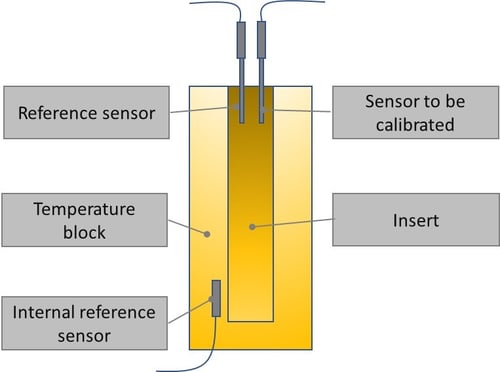To calibrate these short sanitary sensors in a temperature dry-block, there are a few considerations to take into account.
Using a reference sensor
Firstly, when you do the calibration in a temperature dry block, the flange of the sanitary sensor makes it impossible to use a normal external reference sensor in the same insert because it simply does not fit in, the flange covers the insert top and all the holes in the insert.
Picture: Comparing calibration of a normal (long, no flange) temperature sensor using a reference probe on the first picture, with a short sanitary sensor with a flange on the second one. We can see that the short sensor flange covers all the holes in the insert, so it is not possible to insert a normal reference temperature probe:
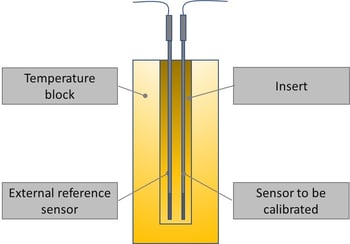
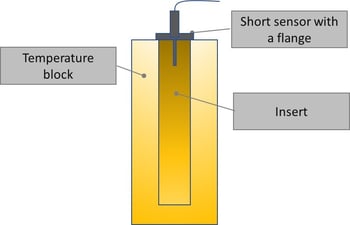
Using internal reference sensor
The dry-block always include an internal reference sensor. Trying to use the internal reference sensor in the dry-block just does not work, because the internal reference sensor is located close to the bottom of the temperature block, and the short sensor to be calibrated is located in the very top part of the insert. The dry-blocks typically control the temperature gradient on a limited range in the bottom of the insert. The top part of the insert typically has a larger temperature gradient, so the top of the insert does not have the same temperature as the bottom of the insert. The size of the gradient depends on the temperature difference between the insert and environment, and how deep you go in the insert.
Picture: The internal reference sensor is located in the bottom of the temperature block, while the short sanitary sensor is located in the very top part of the insert. There is a temperature gradient in the insert, causing the top of the insert being different temperature than the bottom. This is causing error in calibration:
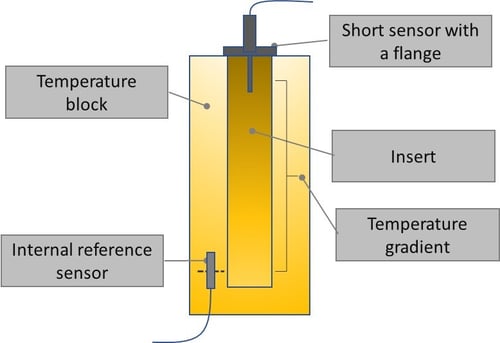
Using a dedicated short reference sensor
As the internal reference sensor in the bottom of the dry-block is not suitable, we need to use a dedicated external reference temperature sensor.
This reference sensor cannot anyhow be a normal long reference sensor, as discussed earlier.
The solution is to use a dedicated reference sensor that is short enough so that it can be immersed into the same depth as the sanitary sensor to be calibrated. Optimally, the middle of the sensor elements should be aligned to the same depth.
Also, the reference sensor needs to have a thin flexible cable so that the cable can fit under the flange of the sanitary sensor. To help that, we can make a grove in the top of the insert where the reference sensor cable fits and the flange of the sanitary sensor still touches the top of the insert.
Naturally the structure of the temperature dry-block needs to be such that the sanitary sensor with the flange fits to its place and touches the insert top end (in some dry-blocks the surroundings are preventing the flange to go deep enough to touch the top of the insert).
Picture: A dedicated short reference sensor is located at the same depth as the short sanitary sensor to be calibrated, ensuring they are measuring the exact same temperature. Also, the reference sensor cable is in the grove, so it does not prevent the flange of the sanitary sensor to touch the top of the insert:
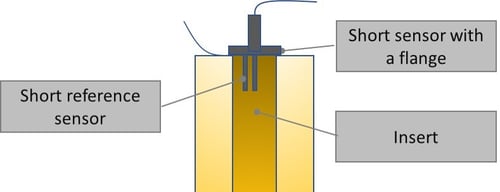
Picture: Some example pictures of how the dedicated insert for sanitary sensor calibration could look like. The hole for the sanitary sensor and for the reference sensor are equally deep and there is a grove where the ref sensor cable can go:
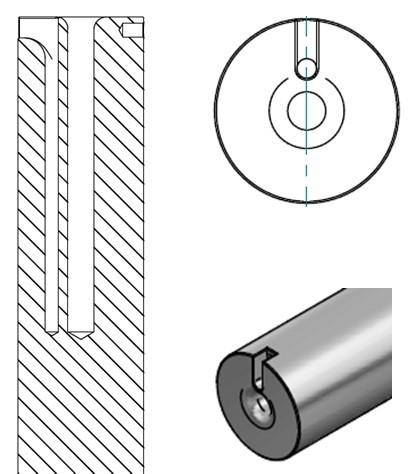
Short sensor without a clamp connection
There are also short temperature sensors without the clamp connection and without the flange. With these sensors you should use an external reference sensor that has been immersed to the same depth as the sensor to be calibrated. The reference sensor should be as similar as possible with the sensor to be calibrated (similar diameter, similar response time, etc.).
The internal sensor in the dry-block cannot be used here either since it is located in the bottom of the temperature block and does not measure the same temperature as the short sensor.
Picture: Calibrating a short sensor (without a flange) using a short reference sensor:
